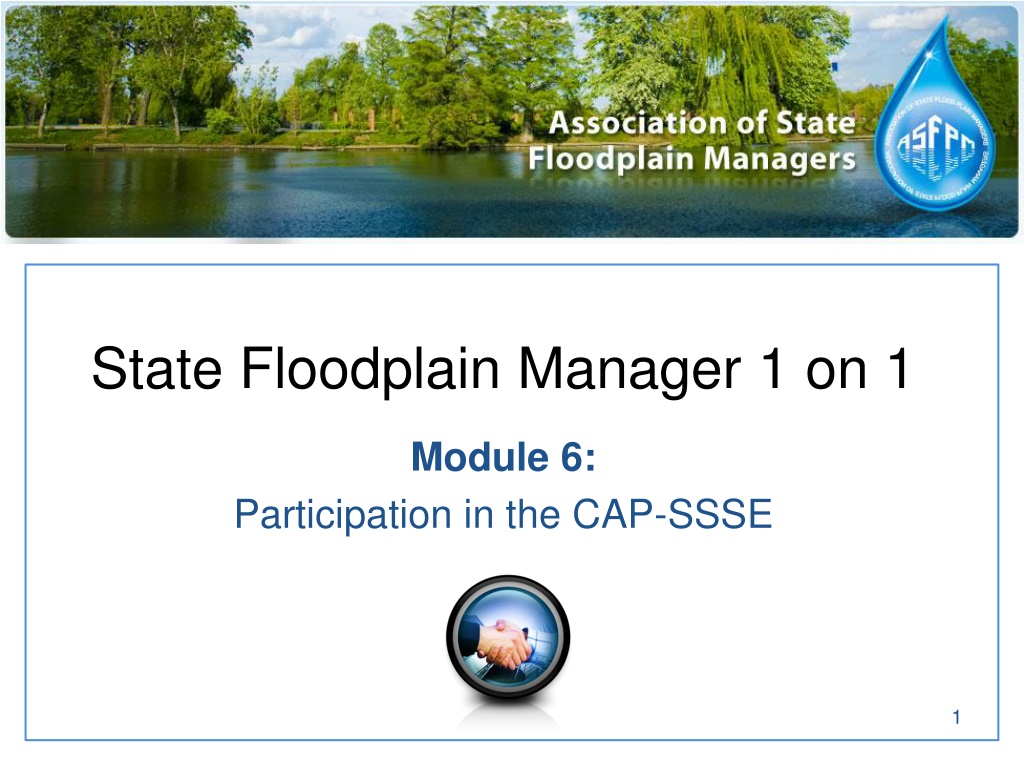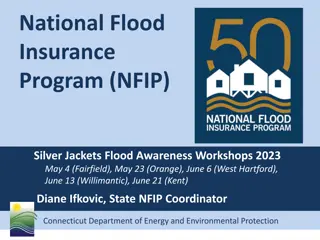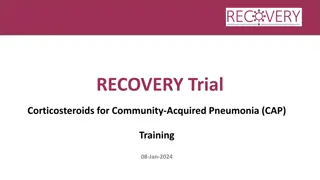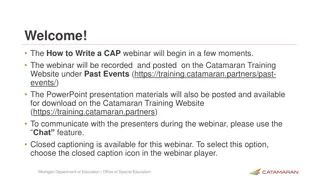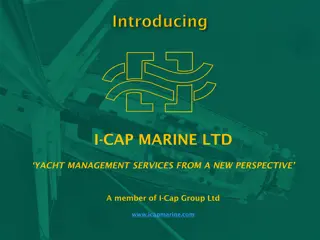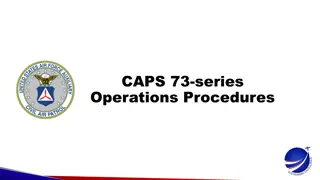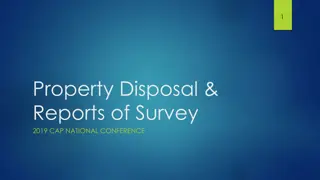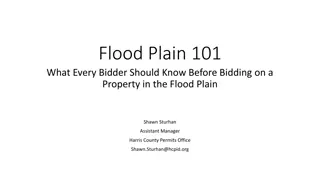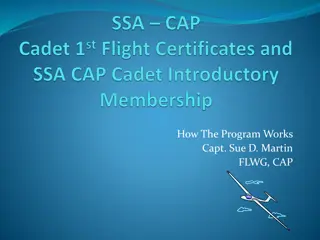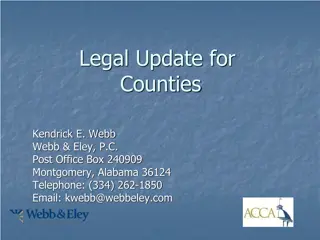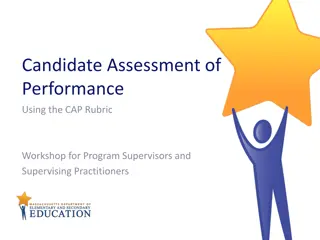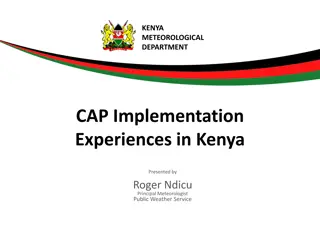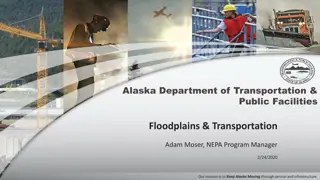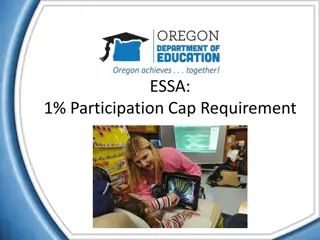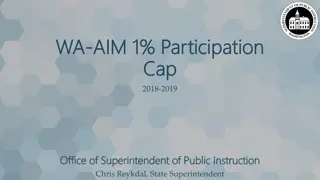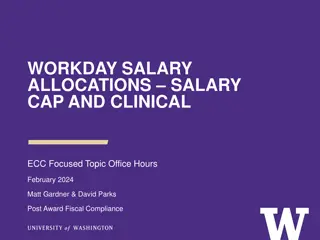State Floodplain Manager 1-on-1 Module 6: CAP-SSSE Participation
This module focuses on developing participants' understanding and skills to be valuable partners to FEMA through the CAP-SSSE program. It covers topics such as leveraging federal programs, building relationships, and obtaining FEMA resources to achieve state floodplain management goals. Through lectures, demonstrations, and visuals, participants will gain insights into NFIP coordination, CAP Planning, and managing CAP-SSSE agreements effectively.
Download Presentation

Please find below an Image/Link to download the presentation.
The content on the website is provided AS IS for your information and personal use only. It may not be sold, licensed, or shared on other websites without obtaining consent from the author. Download presentation by click this link. If you encounter any issues during the download, it is possible that the publisher has removed the file from their server.
E N D
Presentation Transcript
State Floodplain Manager 1 on 1 Module 6: Participation in the CAP-SSSE 1
Mentoring Module 6 AGENDA Introductions Objectives Scope Methods The CAP-SSSE Program Materials and References 2
Introductions PLEASE TELL US YOUR: Name; Job Title; Years spent in Floodplain Management, and; At least one CAP-SSSE question that you want answered before you leave here today. 3
Objectives Upon completion, participants will be able to: 6.1 Be a valued partner to FEMA through NFIP Coordination. 6.2 Understand the background of the FEMA CAP- SSSE program. 6.3 Develop a working knowledge of the components of CAP-SSSE. 4
Objectives (conclusion) Upon completion, participants will be able to: 6.4 Leverage federal programs and funds to achieve state floodplain management goals. 6.5 Build strong state/local FPM relationships around statutory authorities. 6.6 Know where and how to obtain FEMA resources (Resource Library, Technical Bulletins, Policy and Regulations). 5
Scope This module includes the following five topics: Community Assistance Program Background, Purpose, Eligible Activities (Objectives 6.1 and 6.2); CAP Planning (long-range and annual) (Objective 6.1); Developing a Cooperative Agreement (Objectives 6.1 and 6.3); Negotiating CAP-SSSE Agreement with FEMA RO (Objectives 6.1, 6.2 and 6.3), and; 6
Scope Managing your CAP-SSSE Agreement (Objectives 6.2, 6.5 and 6.6). Grants.gov; State and Regional Office Coordination; Quarterly Reporting; Community Information System, and; Closeouts. 7
Scope (conclusion) We will emphasize the following information: Carefully reading the application & submission information; Financial reporting requirement; Extensions procedures; Coordination with the Regional CAP Coordinator, and; CAVs done in High Risk/Tier 1 communities. 8
Methods Material contained in this module will be presented through: Lecture and demonstration supported by 96 visuals/slides, and; SFPM 1 on 1: Student Manual. 9
Program Background The CAP grant provides a funding source to: Support flood loss reduction goals of the NFIP; Build State and community FPM expertise and capability, and; Leverage State knowledge and expertise in working with their communities. 11
Program Background (continued) CAP-SSSE Guidance: Each fiscal year FEMA will provide CAP guidance, known as the Notice of Funding Opportunity (NOFO); CAP is voluntary and eligibility is contingent on need and skill level capability of a state as determined by FEMA, and; Priority is cost-effective, cooperative partnerships. 12
Program Background (continued) Key components: Program Goals; Performance-based Grant Mechanism; Program Guidance, and; Fundable Activities. 13
Program Background (continued) CAP-SSSE Goals: Ensure that the flood loss reduction goals of the NFIP are met; Build state and community floodplain management capability, and; Leverage state knowledge and expertise in working with local communities. 14
Program Background (continued) CAP-SSSE Grant: Annually, FEMA Regional Office and NFIP State Coordinating Office negotiate a CAP-SSSE Agreement. Specific activities and products to be completed by State in return for CAP-SSSE funds. 25% non-federal match for all states receiving funds. 15
Program Background (continued) CAP-SSSE 5-Year Strategic Plan: Purpose is to support collaborative negotiation between FEMA and states; clarifies long-range outcomes and is a communication tool. Strategic issues: funding not matched to need and NFIP coordination service demand; criteria for funding; consistent state need and capability information; accountability for activities and funds. 16
Program Background (continued) 5-Year Strategic Plan: (continued) State mission; State vision; SWOT conclusions; Capacity for NFIP coordination recently based on a GAP Tool analysis discussion; Capability/capacity for effective state program elements; 17
Program Background (continued) 5-Year Strategic Plan: (conclusion) Broad strategies to address issues; Highlights of state specific needs or gaps; Target actions, and; Outcome measures. 18
Program Background (continued) CAP-SSSE Statement of Work (SOW): Purpose is to address specific CAP-SSSE grant criteria. This work plan will provide a framework for specific task measures (output, deliverables) and financial accountability (time and cost) are all present. 19
Program Background (continued) CAP-SSSE SOW content: General State time and effort information; Summary analysis for CORE activities; Narrative that interprets the results versus the baseline, and; Discussion of unmet needs and budget. 20
Program Background (continued) After the CAP-SSSE Roundtable in Madison, WI (2010): FEMA HQ changed how it allocated CAP dollars to the Regional Offices. Previously based on number of policies, number of communities, and growth rate. Now it is based on the above criteria plus State mapping contributions and land area. 21
Program Background (continued) Authorizing Authority for the Program: The CAP-SSSE is authorized under the NFIA of 1968, as amended and the Flood Disaster Protection Act of 1973, as amended, 42 U.S.C. 4001 et seq. 22
Program Background (continued) Authorizing Authority for the Program: Section 1361 of the FDPA of 1973 authorizes FEMA Administrator to carry out studies and investigation, utilizing to the maximum extent practicable the existing facilities and services of the Federal departments or agencies and State and local government agencies, and any other organizations, with respect to the adequacy of State and local measures in flood-prone areas as to land management and use, flood control, flood zoning, and flood damage prevention, and the Administrator may enter into any contracts, agreements, or other appropriate arrangements to carry out such authority. 23
Program Background (conclusion) Job Aid 1 Appropriation Authority for the Program: CAP-SSSE is implemented under the Flood Hazard Reduction pursuant to 42 U.S.C. Section 4102. The appropriation for the line item is from NFIP fee income and appropriated under the National Flood Insurance Fund appropriation for floodplain management. 24
Program Purpose (The raison d etre.) Provide a mechanism to fund the State s NFIP floodplain monitoring and oversight tasks, such as: Community Assistance Contact/Community Assistance Visits; Ordinance reviews; NFIP/FPM training, and; Provision of technical assistance. 25
Eligible Activities All documentation and products are reviewed by FEMA regional staff throughout the annual CAP-SSSE period. The Regional Office (RO) prescribes those eligible and ineligible tasks, as well as priority tasks for funding. RO will negotiate all tasks and costs with the State for adherence to its guidance prior to award of CAP funds. Tasks can be reviewed by the RO s determination, along with the conduct of annual meetings with all States concerning program activities. 26
Eligible Activities (continued) A few fundable 2017 activities are: CAV visits and CAC contacts*; Ordinance assistance*; CIS input*; Strategic Planning; CAP Gap analysis (optional); State Model Ordinance updates and monitoring of State Regulatory Environment; 27
Eligible Activities (continued) Outreach, Workshops and other training; ASFPM activities and credentialing; Meetings (travel reimbursements for ASFPM conferences, Regional CAP Conferences and in-State Silver Jackets meetings. Others can be considered. General Technical Assistance; Enrollment of Communities; CRS support; 28
Eligible Activities (conclusion) Mapping Coordination Assistance; Coordination with Other State Programs and Agencies, and; Assistance to Communities in Responding to Disasters. 29
The key to crafting the Cooperative Agreement between you and FEMA is setting vague goals that are a combination of jargon and wishful thinking. 30
Cooperative Agreement DEVELOPING A COOPERATIVE AGREEMENT FEMA Regional Offices and the designated State coordinating office negotiate a CAP-SSSE Agreement that specifies activities and products to be completed by a State in return for CAP-SSSE funds. There is a 25% non-federal match for all States receiving CAP-SSSE funds. 31
Cooperative Agreement (continued) Example of cost match: Percent recipient contribution multiplied by the value of the federal contribution in US dollars. I.E.: If a program requires a 25% cost match and the federal contribution is $100K, the recipient contribution is calculated as (0.25) x $100K = $25K. 32
Cooperative Agreement (continued) Restrictions: CAP-SSSE funds cannot be used for: conducting floodplain studies, developing floodplain maps, supporting/maintaining web-based digital mapping platforms, ASFPM or other professional association memberships/dues. Cannot be used to duplicate/reimburse for state- required and state-funded review activities (state permits). 33
Cooperative Agreement (continued) Restrictions: (continued) Funds can only be used to reimburse states for activities conducted, not for funding people. This means: Only staff that are doing the approved activities, not someone who is only doing the financial or application tasks. This is a reimbursement grant for time used to complete the negotiated, eligible activities and not the FTE salaries themselves. 34
Cooperative Agreement (continued) Restrictions: (conclusion) If the State recipient doesn t maintain expertise and capability to conduct CAP activities, a remedial plan must be developed. That can lead to loss of CAP funding the next year, if expertise and capability isn t restored. 35
Budget Example Job Aid 2 Example of a CAP budget overmatch submitted to RO staff. 36
FEMA Form 20-20 Job Aid 3 37
Cooperative Agreement (continued) Job Aid 4 Background: The CAP-SSSE has followed the Cooperative Agreement mechanism since 1980. The key mechanism for providing community technical assistance, community NFIP performance evaluation, and building/maintaining State and community FPM expertise and capability. 38
Cooperative Agreement (continued) Background: The Cooperative Agreement (CA) prescribes those eligible and ineligible tasks, as well as priority tasks for funding. RO staff negotiate all tasks and costs with the State before the award. The RO will provide an annual CAP-SSSE program guidance document to the NFIP State Coordinator. 39
Cooperative Agreement (continued) There potentially could be substantial FEMA RO involvement throughout the CAP-SSSE Cooperative Agreement process. FEMA reserves the authority to manage and direct recipient actions. The RO determines the appropriate levels of effort for each activity to ensure that performance metrics are met. 40
Cooperative Agreement (continued) What level of effort for each activity is monitored: The RO retains final approval of State reviewed community ordinances (to join the NFIP). A mandatory map adoption rate of 90% or higher. Final approval concerning which communities will receive State provided training and tech assistance. Number of CAVs by the State and who will be CAVed. 41
Cooperative Agreement (continued) What level of effort: (continued) Compliance follow-up actions. FEMA requires advance approval of any actions that leads towards FEMA placing a community on probation or suspension. Final approval for a Declared Disaster community to receive CAP tech assistance. Requires a close collaboration with FEMA mitigation staff to monitor all aspects of program goals. 42
Cooperative Agreement (continued) What level of effort: (conclusion) The RO must approve any requests to vary or substitute activities performed (i.e. staffing, overtime and other management process). FEMA can stop a State s funded activity immediately, if the State fails to meet one or more of the previous conditions. 43
Cooperative Agreement (continued) On-line Application Process: DHS makes all funding opportunities available through its storefront at http://www.grants.gov Customer support hotline number is 800-518-4726. The State applicant must submit six OMB Standard Forms when applying for CAP funds. 44
Cooperative Agreement (conclusion) Job Aids 5 - 11 On-line Application Process: SF 424: Application for Federal Assistance; SF 424A, Budget Information; SF 424B, Standard Assurances; SF LLL, Disclosure of Lobbying Activities; Grants.gov (GG) Lobbying Form FEMA Form 112-0-3C, Certifications Regarding Lobbying; Debarment, Suspension; and Drug-Free Workplace. 45
After Action Review Feel like you are missing something vital? Let s do a quick review. 46
Negotiating the CAP-SSSE Agreement Things to cover with your FEMA Regional Office CAP staffer: The CAP Guidance will stipulate the FEMA activity priorities. Such as: In Fiscal Year 20xx, the program will focus on compliance and enforcement. 47
Negotiating the CAP-SSSE (continued) Things to cover with your FEMA Regional Office CAP staffer (continued): Newsletters; Public meetings (include all support actions & documentation requirements); Meetings/training workshops with special interest groups (realtors, insurance agents, surveyors, etc.); 48
Negotiating the CAP-SSSE (continued) Things to cover with your FEMA Regional Office CAP staffer (conclusion): Training and outreach, and; Create/support a statewide organization for local FPM. 49
Negotiating the CAP-SSSE (conclusion) In such a scenario, the priorities could be: The selection of CAC/CAV communities; Special attention to mechanical, electrical, and utility equipment and flood openings, and; The initiation of a State CAV. 50
